The sleep problem
NASA’s manned space experience began with Alan Shepard’s 5-minute sample of weightlessness in May 1961 on board the first manned Mercury spacecraft. In less than eight years, through the Mercury and Gemini programmes, NASA became increasingly sophisticated in Earth-orbit operations, which culminated in October 1968 with the 12-day ‘shakeout’ flight of Apollo 7 when the first manned Block II
W. D. Woods, How Apollo Flew to the Moon, Springer Praxis Books,
DOI 10.1007/978-1-4419-7179-1 7. © Springer Science+Business Media. LLC 2011
|
Preflight processing of the Apollo 8 command module at KSC. (NASA) |
spacecraft was put through its paces. Then, with the first Moon-bound flight of the pioneering Apollo 8 on 21 December 1968, managers found themselves vexed by a very basic problem – the disturbed sleeping patterns of the three-man crew in the limited volume of the command module. Something had changed in the nature of spaceflight.
Throughout the early years of planning for the Apollo lunar flights, it had always been assumed that the best arrangement for sleep would be a rotation system in which at least one crew member would always be awake to monitor the systems. Apollo 7 followed this regime. Donn Eisele, the command module pilot, took his rest period alone. The commander Wally Schirra and lunar module pilot Walt Cunningham took theirs simultaneously. The crew never reported problems with this arrangement during their debriefing; although any tiredness could have been masked by the commander’s irritating head cold and perhaps the irritability all three men displayed could have been exacerbated by lack of sleep. In any case, Apollo 7 was confined to Earth orbit and its crew were not in the position of being the first humans to orbit another world, never mind not being the first to leave Earth’s vicinity.
filings started well on board Apollo 8 with only a bout of space motion sickness from the commander Frank Borman to cause any medical concern. The coast to the Moon was relatively uneventful and the crew kept the ship running smoothly. The major activity was by Jim Lovell as the CMP, who practised the cislunar navigational techniques that subsequent crews would use. However, as the spacecraft’s flight progressed, the crew found that their planned sleep patterns became increasingly disrupted.
A common problem occurred whenever a crewmember spoke with mission control, as his chatter u’ould disturb the slumber of his colleague. Why this should be a problem on this flight when it never previously arose may be that, unlike an Earth – orbit mission of the lime, there were no long periods during the coast when radio silence was enforced by the sparse distribution of the tracking sites. At the time, conversation with mission control during Earth orbit flights could only occur when a ground station was in view’ and that was often for less than ten minutes at a time. During the coast to the Moon, the flight controllers in mission control were in permanent communication with the spacecraft and Capcom would not only speak to the crew’ whenever an operational need arose but would also engage in idle chat, with the result that communication was often ongoing. Also, with three men occupying the very cramped confines of the cabin, any activity to carry out chores tended to disturb the crewman sleeping on or underneath his couch. In the command module there was no place to escape from colleagues and there were no sleeping bags. By the time the Apollo 8 crew reached their destination, they were all somewhat groggy from their attempts at napping, and it took the adrenaline produced by the excitement of making ten orbits around an alien planet to help them to perform their duties successfully and safely. All three were captivated by the forbidding, stark landscape that was passing beneath their window’s. They worked hard at their full schedule of photography, TV broadcasts and navigational sightings and all the time kept up a busy chatter with mission control until the seventh orbit, when Borman decided to discard the timeline for the remainder of their orbital sojourn. Although it was an incredibly sophisticated machine for the technology available in the 1960s, the spacecraft could only achieve its capability by being necessarily complex and intricate. There were countless ways in which a tired crew could kill themselves through inappropriate operation of its many controls. Borman knew this, and ordered Jim Lovell and Bill Anders to take a rest before the trans-Earth injection burn.
Mission planners took the Apollo 8 experience to heart when they reviewed the sleeping arrangements for subsequent flights. It w’as decided that since the controllers on the ground had a better view of the spacecraft’s systems through telemetry, the crews would sleep concurrently, following Houston time, with one crewman wearing a headset in case Houston felt the need to wake them up. As subsequent missions became increasingly complex and demanding, this change in
the sleep regime allowed crews to sleep well and helped them to cope more easily with the immense physical and mental strain they had to endure when their opportunity came to explore another world in the very limited time Apollo could give them.











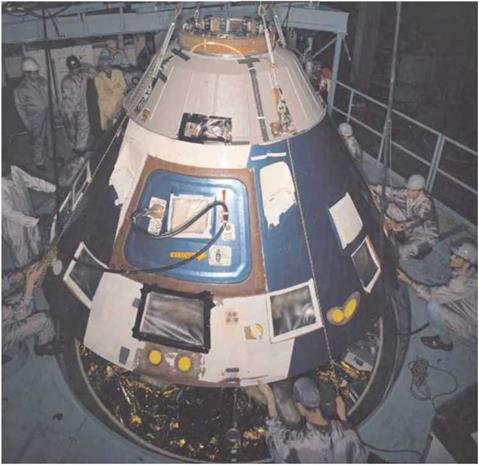

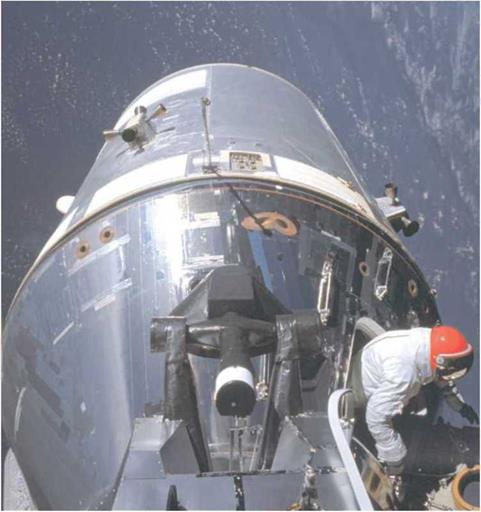
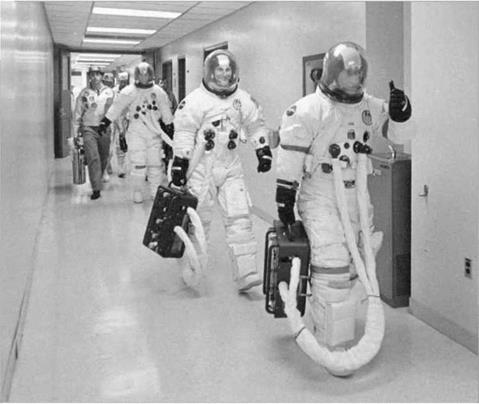
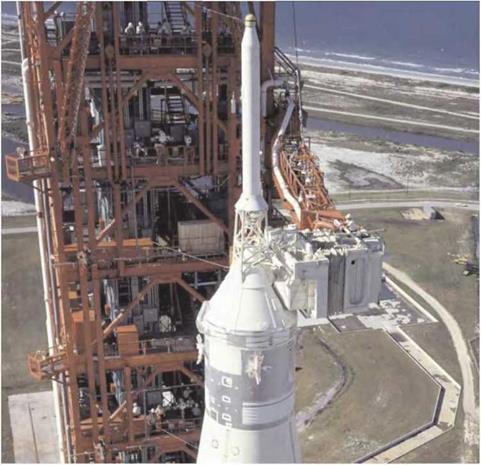
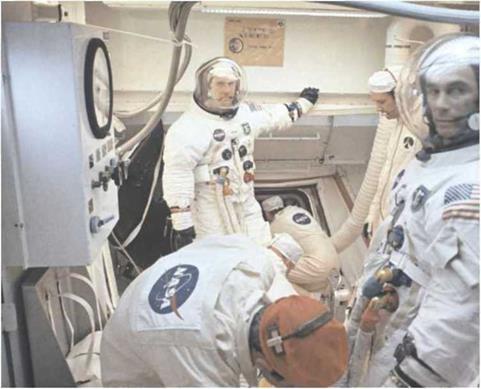
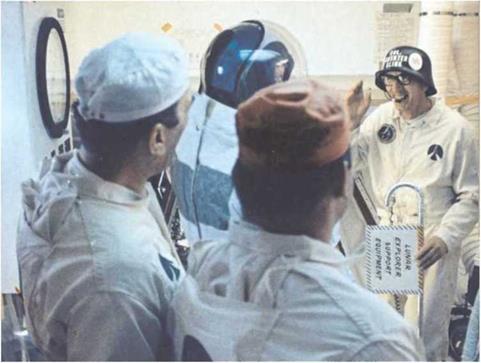
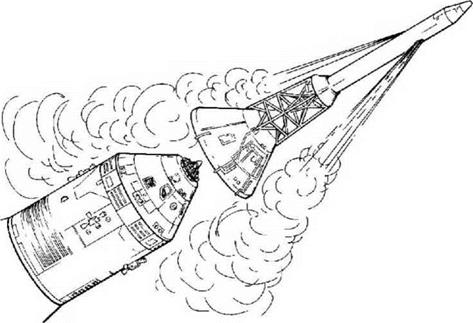

 leading hemisphere of the body, the exchange is away from the spacecraft. It gets a tug from the planet against its orbital motion so heliocentric velocity is reduced and its orbit gets smaller.
leading hemisphere of the body, the exchange is away from the spacecraft. It gets a tug from the planet against its orbital motion so heliocentric velocity is reduced and its orbit gets smaller.
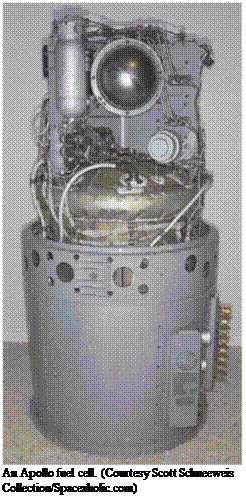 The Apollo command module (and to a lesser extent the lunar module) could be thought of as a mini-planet. All the basic requirements for human life over a two – week period were brought together inside a sealed conical machine less than four metres across and little over three metres high that could transport its occupants between worlds. Along with its service module, the spacecraft provided air, water, power and propulsion. It included a means of navigating across space and a way to negotiate Earth’s atmosphere upon return. It contained adequate supplies of food and warmth as well as the equipment that its crew would need for a programme of science during their journey. The life-support infrastructure of the Apollo spacecraft was under the watchful eye of the flight controller who sat at the EECOM console.
The Apollo command module (and to a lesser extent the lunar module) could be thought of as a mini-planet. All the basic requirements for human life over a two – week period were brought together inside a sealed conical machine less than four metres across and little over three metres high that could transport its occupants between worlds. Along with its service module, the spacecraft provided air, water, power and propulsion. It included a means of navigating across space and a way to negotiate Earth’s atmosphere upon return. It contained adequate supplies of food and warmth as well as the equipment that its crew would need for a programme of science during their journey. The life-support infrastructure of the Apollo spacecraft was under the watchful eye of the flight controller who sat at the EECOM console.